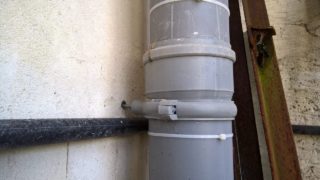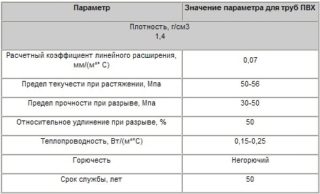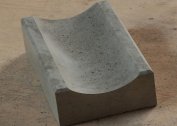The arrangement of the sewage system involves the use of pipes of various diameters and sizes (lengths). In this case, products from different materials can be used. Polyvinyl chloride (PVC) is popular. For the inside of the collector take tubes with a cross section of 25 to 150 mm. Large PVC pipes for external sewage have a diameter of 220 mm.
Scope of application
Products with a diameter of 150 mm are more often used in such cases:
- arrangement of a public riser in an apartment building;
- outlets from toilets and other plumbing points equipped with a tank for collecting water / drains;
- transitional sections of the sewer system from the house to the outside;
- the outer part of the collector, provided that the total volume of effluents per day does not exceed 100 liters: a 150 mm polymer pipe can be installed as an element of autonomous sewage in the private sector, but in this case it is necessary to use tubes of red color, indicating that the polymer is suitable for operation in more difficult conditions (temperature differences, soil swelling, static / dynamic loads).
Properly selected tube cross-section for the outer part of the sewage system ensures good transportation of wastewater without pressure and the absence of blockages in the system.
Technical characteristics of PVC pipes
There are two types of PVC products on the market - PVC-U and PVC pipes. The former belong to the category of the most stable strong polymers. Such products are inert to aggressive media, alkalis, acids, oils and alcohols. At the same time, unplasticized polyvinyl chloride can easily withstand high loads, especially products of the SN8 class. They are even stacked under heavy traffic freeways. Standard gray and red sewer pipes with a diameter of 150 mm made of PVC and NPVH have the following technical characteristics:
- Low flammability. The material is not flammable. Only at a temperature of +120 degrees Celsius does melting begin with the release of carbon monoxide into the atmosphere.
- Resistance to transported media with temperatures up to +60 degrees. Short-term (if the total volume of drained water does not exceed 30 liters) the polymer can withstand up to +95 degrees.
- Inertness to temperature fluctuations. In frost, plastic does not crack. But with a high-impact spot strike, a frozen polyvinyl chloride can burst.
- Good elasticity and a tendency to small linear stretching, which is especially true at the time of temperature changes in the system.
PVC pipes are produced strictly according to GOST (No. P 51613-2000), about which there is a corresponding marking on the outer wall of the product. Permissible pipe length - from 4 to 12 m / pc.
Principles and features of the installation of polyvinyl chloride pipes
Mount a piece of sewage from PVC tubes with a cross-section of 150 mm into the socket; successively insert each subsequent piece of line into the previous one (into its wide part). Act here in this way:
- A narrow portion of each product is lightly treated with sandpaper to increase the adhesion of the silicone sealant to the polymer walls. The treated tube section does not exceed 10-15 cm from the edge.
- A rubberized seal is inserted into the bell. As a rule, it is already included with the tube. The sealant can be treated with sealant.
- Lubricate the prepared part of the tube with emery. The sealant is applied in a thin layer.
- Insert the element into the bell until it stops, but without excessive zeal.
- The complete drying of the silicone takes about 24 hours. After that, the system can be operated.
Experts highlight several key points that need to be considered when installing pipes with a cross section of 150 mm:
- When installing the collector, it is important to observe a bias towards the receiver or central line. This will help prevent clogging and stagnation in the system.
- Moving from all plumbing points towards a septic tank or public collector, the diameter of the sewer pipeline only increases or its constant cross section is maintained, but it does not decrease.
- It is strongly not recommended to make sharp turns in the system by 90 degrees. They will provoke stagnation of feces. If you need to rotate the system at this angle, you need to use two rotary adapters of 45 degrees each.
- If branching is supposed in the system, revisions are mounted at these points.
- The vertical section of the pipeline is additionally attached to the wall with special clamps. The pitch of the clamps is 35-45 cm.
- To change the cross section of the collector, special adapter fittings are used.
Plastic pipes create a slight noise when sewage flows through them. This is due to the moderate stiffness of the material. To drown out third-party sounds, you can close the system in a box or put a special shell on top of the tubes.
The price of plastic sewer pipes with a diameter of 150 mm varies depending on its purpose (external / internal sewage) and the length of one section. In addition, the cost of PVC elements can vary across regions of Russia. On average, one element with a length of 500 mm will cost from 90 to 150 rubles.





